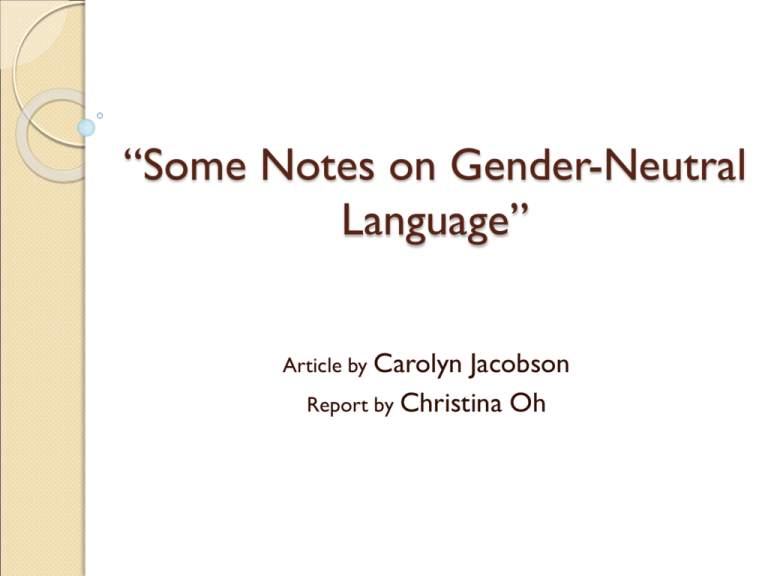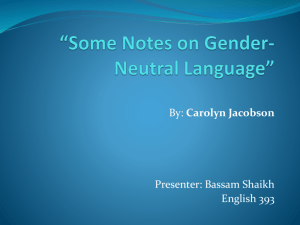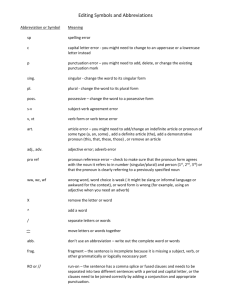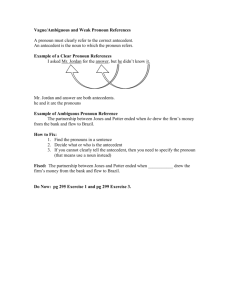“Some Notes on Gender
advertisement

“Some Notes on Gender-Neutral Language” Article by Carolyn Jacobson Report by Christina Oh Introduction & Main Points Every language reflects prejudices of its society and English is no exception. As a reader and writer, we have to be aware of different conventions and connotations that may be elicited by a certain time period. ◦ “Man” was once used as be a generic term referring to all humans, but is used now used to refer mainly to adult males. ◦ “He” is a pronoun that was intended to refer to both male and female genders but because it has caused some discrepancies in legal documents. ◦ There are several solutions for solving the pronoun problem. “Man” The word “man” was originally a generic word used to describe all humans. As time progressed, “man” became a more inclusive word only to refer to adult males. The Old English words for male and female were waepman and wifman. Waepman eventually evolved to just man and wifman evolved to be woman. By the 18th century, “man” was no longer used as a generic word referring to all humans. “Man” – cont’d When writing about the French Revolution in the 18th century, Edmund Burke took extra measures to insure that his use of “man” was not misunderstood. ◦ “Such a deplorable havoc is made in the minds of men (both sexes) in France…” Unfortunately, Thomas Jefferson didn’t take the same distinction when declaring that “all men are created equal” during a time when women already didn’t have the right to vote. Modern dictionaries and studies of college students and school children reveal that “man” and “men” are taught to bring up images of males only. The Pronoun Problem When the first grammars of modern English were being written in the 16th and 17th centuries they were written by male authors to help upper class boys learn Latin. Masculine-gender pronouns weren’t used to refer to both sexes and it reflected the cultural dominance of males. The use of “he” came about when grammarians were trying to change the traditional use of “they” as a singular pronoun. In 1850, Parliament made a new law that said “words importing the masculine gender shall be deemed and taken to include females”. Other societies have attempted to the same, but was often conveniently overlooked. The Pronoun Problem – cont’d As of the 1990’s, the pronoun “he” along with “man” is not a truly generic term as is it was originally intended to be. Because of the frequency of the misuse of such pronouns many people, especially women, feel that pronouns that were meant to be generic exclude women. Solving the Pronoun Problem Using “they” as a singular pronoun: ◦ Most people use “they” as singular when writing and speaking informally. ◦ However, many people are annoyed by the incorrect grammar of using “they” as a singular pronoun. ◦ Nonetheless, the singular use of “they” occurs with increasing frequency. Solving the Pronoun Problem – cont’d Double-pronoun constructions have made a comeback: ◦ Rather than just saying “he” and hoping that people will include females, some people have started using “he or she”. ◦ However, overusing double-pronouns can sound awkward. Solving the Pronoun Problem – cont’d Eliminating pronouns all together: ◦ One could avoid using pronouns at all. ◦ For example, instead of saying “a first grader can feed and dress himself ” “a first grader can eat and get dressed w/o assistance” Conclusion Gender-neutral language is an issue about audience and awareness, not about freedom of speech or rules on writing. Most major textbook publishers, professional and academic groups (i.e. APA, New York Times, Wall Street Journal) support the use of gender-neutral language and avoid using language that isn’t. Many law, psychology, and literature journals won’t print articles or papers that use gender-inclusive language. Questions?







